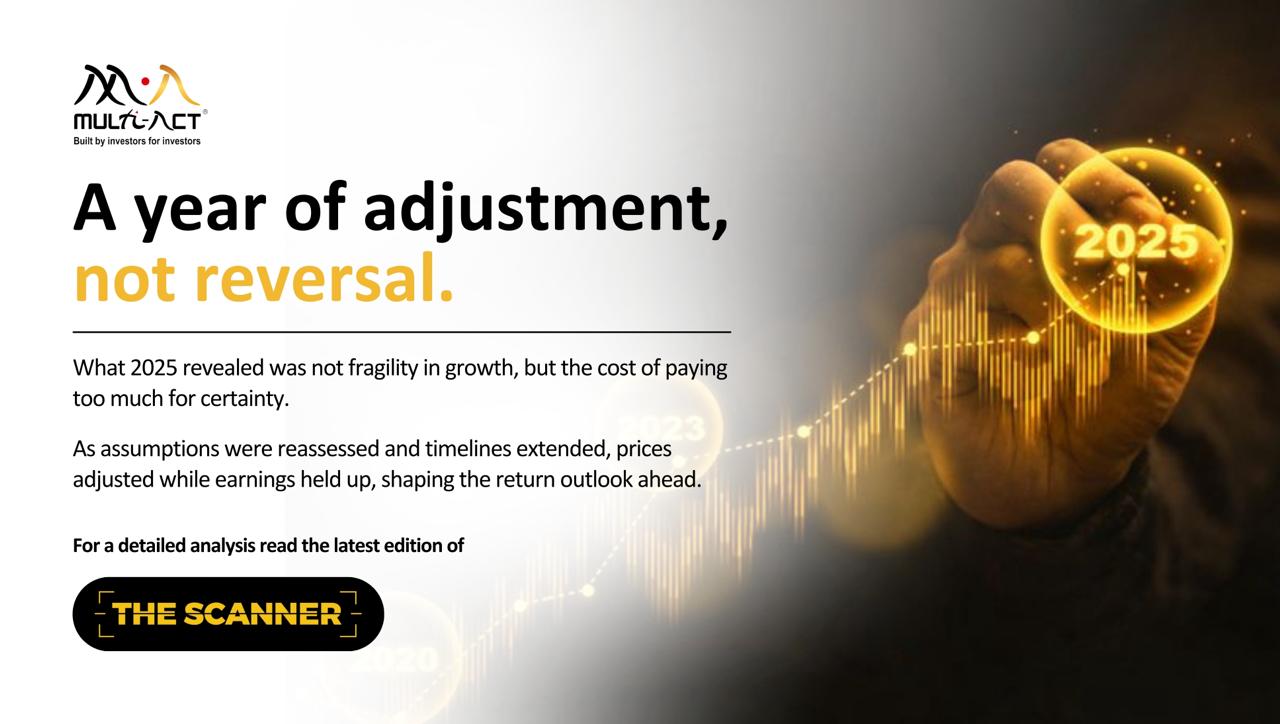
What Happened and What’s in Store for 2026
2025 did not challenge growth. It challenged assumptions. As expectations moved ahead of actual delivery, prices adjusted … Continued
Read more14 November 2018

As markets in general and especially the small and mid-cap indices are going through turbulent and volatile times, we thought it would be appropriate to understand the causes of volatility from a new perspective – that of chemical-induced behavioural motivations.
Stock prices fluctuate owing to a combination of changes in intrinsic value or changes in multiples. Multiples change because perceptions about the Company in terms of growth prospects, business quality or longevity change or also because there could be excess liquidity chasing stocks. In the short-run, a large percentage of price fluctuation is due to perception changes. While, at times, there is strong research backing a perception change, sometimes it’s just to do with the mood of the market participants. Sometimes, it is also a self-fulfilling prophecy where the multiples change first, giving more reasons to justify the change to people who take comfort from price momentum leading to a further price movement until the entire thing collapses. This works when stocks are rising as well as falling.
Let us look at the data for NIFTY Companies to understand price fluctuations better. Firstly, we consider the weighted average yearly price volatility of current Nifty Companies – which is the difference between their 52 W high price for the year and the 52 W low price for the year. And then we compare it with the Nifty EPS growth.

Source: Ace Equity and Multi-Act Internal Database
As we can see, the volatility, even in NIFTY stocks is much higher than the earnings growth rates of the NIFTY companies. The median YEARLY volatility of NIFTY companies is 55% and about 85% of this volatility is due to sentiment/perception change and only 15% is due to EPS growth. And this is just for NIFTY companies which are more established. As we go down the listed universe, sentiment plays an even more crucial role.
To put it more simply, in a normal year, market participants assign a P/E of 13 at some point in the year and a P/E of 20 at some other point in the same year to the same stocks. And there are years like 2009 or 2010 or 2015 when such behaviour is even more pronounced. Why does this happen? Why are mood swings or sentiment changes so impactful?
John Coates, once a trader on Wall Street and now a neuroscientist at Cambridge University, in his book “The hour between the dog and the wolf” uses concepts from biology to explain such wide mood swings. Following is an excerpt from an article in the Economist that explains this
“Financial traders, he says, are influenced by what is going on in their bodies as well as in the markets. Two steroid hormones—testosterone and cortisol—come out in force during the excesses of bull and bear markets.
Testosterone, “the molecule of irrational exuberance”, is released into the body during moments of competition, risk-taking, and triumph. In animals, this leads to something called the “winner effect”. A male that wins one battle goes into the next one primed with higher levels of testosterone, helping him to win again. Eventually, though, confidence becomes cockiness. The animal starts more fights and experiences higher rates of mortality.
Mr. Coates thinks the exuberance that turns a market rally into a bubble may be fuelled by the same chemical. Some of this is based on traders he knew who became ever more convinced of their own invincibility during the dotcom era. But he also offers harder evidence. In one experiment Mr. Coates sampled testosterone levels in traders in London and found that higher levels of the hormone in the morning correlated with beefier profits in the afternoon. Such profits came from taking higher risks, not greater skill.
Biology may also be responsible for worsening market sentiment in bad times. The body’s response to prolonged periods of stress is to secrete increasing amounts of cortisol, a hormone that marshals resources to cope with crises. Sure enough, Mr. Coates finds that cortisol levels in traders’ bodies fluctuate in line with market volatility, even displaying a striking correlation with the prices of derivatives. A burst of chemicals can be helpful. Good traders seem to produce a lot of hormones, but only for short periods of time. The trouble comes when cortisol remains in the body for extended periods. Rational analysis becomes harder, allowing emotional responses to gain the upper hand; risk aversion grows as testosterone production is suppressed. “During a severe bear market,” writes Mr. Coates, “the banking and investment community may rapidly develop into a clinical population.”
While we may think that such chemical changes only happen in extreme markets, our understanding is that these happen in lower degrees at all times in some stock or the other. And this is the reason why price volatility is much higher than intrinsic value growth rates. And markets over-react in both extremes.
This conceptual insight helps us better understand why stocks overshoot in both directions and if there is too much testosterone or too much cortisol visible in market participants, it might just make sense to take the counter trade. Off-course, what’s happening to others will happen to us as well and taking the counter view will not come easily. But, knowing that one needs to act counter-intuitively at such times is at least a start.
With the events that have happened in the last few weeks and the sharp corrections, especially in the small and mid-cap stocks, we see signs of testosterone levels coming down. If this stress persists for some time, we could see increased cortisol levels as well.

2025 did not challenge growth. It challenged assumptions. As expectations moved ahead of actual delivery, prices adjusted … Continued
Read more
Macro numbers alone rarely tell the full story. When jobs, consumption, credit, and inflation are considered together, … Continued
Read more
The AI story everyone sees is technological. The story that a few notice is financial. Revolving expenditures, … Continued
Read moreReceive monthly updates by signing up to our newsletter.
| Sr. No. | Received from | Pending at the end of last month | Received | Resolved* | Total Pending # | Pending complaints > 3 months | Average Resolution time^ (in days) |
|---|---|---|---|---|---|---|---|
| 1 | Directly from Investors | 0 | 0 | 0 | 0 | 0 | 0 |
| 2 | SEBI (SCORES) | 0 | 0 | 0 | 0 | 0 | 0 |
| 3 | Other Sources (if any) | 0 | 0 | 0 | 0 | 0 | 0 |
| Grand Total | 0 | 0 | 0 | 0 | 0 | 0 | |
Number of complaints received during month against the IA due to impersonation by some other entity: Nil
Note: In case of any complaints received against the IA due to impersonation of the IA by some other entity, the IA may adjust the number of such complaints from total number of received/resolved complaints while preparing the above table. Further, IA must close such impersonation related complaints after following the due process as specified by SEBI/ IAASB.
* Inclusive of complaints of previous months resolved in the current month.
# Inclusive of complaints pending as on the last day of the month.
^ Average Resolution time is the sum total of time taken to resolve each complaint in days, in the current month divided by total number of complaints resolved in the current month.
| Sr. No. | Month | Carried forward from previous month | Received | Resolved* | Pending# |
|---|---|---|---|---|---|
| 1 | April, 2025 | 0 | 0 | 0 | 0 |
| 2 | May, 2025 | 0 | 0 | 0 | 0 |
| 3 | June, 2025 | 0 | 0 | 0 | 0 |
| 4 | July, 2025 | 0 | 0 | 0 | 0 |
| 5 | August, 2025 | 0 | 0 | 0 | 0 |
| 6 | September, 2025 | 0 | 0 | 0 | 0 |
| 7 | October, 2025 | 0 | 0 | 0 | 0 |
| 8 | November, 2025 | 0 | 0 | 0 | 0 |
| 9 | December, 2025 | 0 | 0 | 0 | 0 |
| Grand Total | 0 | 0 | 0 | 0 | |
* Inclusive of complaints of previous months resolved in the current month.
# Inclusive of complaints pending as on the last day of the month.
| SN | Year | Carried forward from previous year | Received | Resolved* | Pending# |
|---|---|---|---|---|---|
| 1 | 2021-22 | 0 | 0 | 0 | 0 |
| 2 | 2022-23 | 0 | 0 | 0 | 0 |
| 3 | 2023-24 | 0 | 0 | 0 | 0 |
| 4 | 2024-25 | 0 | 0 | 0 | 0 |
| Grand Total | 0 | 0 | 0 | 0 | |
* Inclusive of complaints of previous years resolved in the current year.
# Inclusive of complaints pending as on the last day of the year.